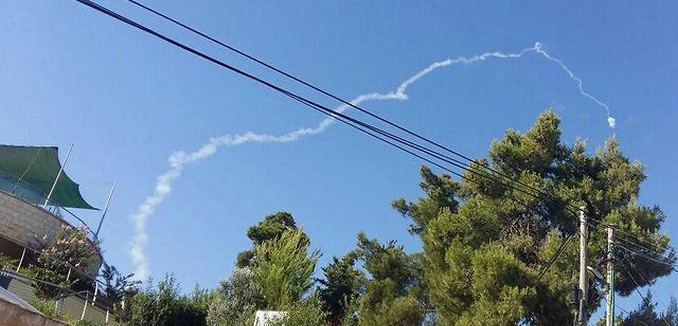An unmanned aerial vehicle crossed into Israeli airspace from Syria on Sunday afternoon, prompting the IDF to fire anti-aircraft missiles at the target before it returned to Syrian airspace.
Israel fired two Patriot interceptors and an air-to-air missile at the drone, and scrambled fighter jets in an attempt to down it.
“The aircraft was detected prior to entering the nation’s territory and was fully tracked by the Israel Air Force,” the Israeli military said in a statement. “From the initial investigation, it was found that three intercept attempts took place as per procedure. No hit of the target was identified.”
The IDF determined that no rockets had been fired at Israel during the incident, although the launch of the Patriot missiles triggered air raid sirens across the Golan. Kibbutz Ayelet Hashahar experienced brush fires and a 14-year-old girl was lightly injured by shrapnel, presumably from the Patriot interceptors that landed in the area.
A source from the Iran-backed terrorist organization Hezbollah said his group flew the drone “as part of an operation against Israel,” according to an unconfirmed report carried by Israel’s Channel 10.
Although the IDF believes that the drone is Russian-made, it is still trying to determine who it was operated by, Israel’s Channel 2 reported. According to a tweet posted by Anes al-Naqqash — a Hezbollah-linked Lebanese fighter — his terrorist organization sent the drone to photograph Israeli military maneuvers in the Golan.
This is not the first time that Israeli airspace has been penetrated by an unfriendly aircraft in recent years.
In August 2014, the IDF successfully shot down a drone that crossed into Israel from the Quneitra region in Syria, which is immediately adjacent to the Golan. A month later, the military shot down a Syrian fighter jet that breached Israeli territory.
While Hezbollah has been increasingly involved in fighting on behalf of the Iran-backed regime of Syrian dictator Bashar al-Assad, the group’s leaders often emphasize their goal of attacking Israel.
In May, Hezbollah leader Hassan Nasrallah called on the Lebanese terrorist group to fight a war of “comprehensive resistance” against Israel, and threatened in February to target ammonium tanks in Haifa, an attack which could kill tens of thousands of people.
Hezbollah has amassed a stockpile of more than 130,000 rockets — more than all non-U.S. NATO countries combined. These rockets are heavily embedded in Lebanese civilian infrastructure, and there have been multiple reports of Hezbollah offering reduced-price housing to Shiite families who allow the terrorist group to hide rocket launchers in their homes. This means that any decision by Hezbollah to start a war with Israel would likely have devastating consequences for the Lebanese population. One senior Israeli military official told the New York Times in 2015 that Lebanese civilians are “living in a military compound.”
“We will hit Hezbollah hard, while making every effort to limit civilian casualties as much as we can … [but] we do not intend to stand by helplessly in the face of rocket attacks,” the official added.
United Nations Security Council Resolution 1701, which was passed unanimously to end the 2006 war between Israel and Hezbollah, forbids the transfer of weaponry to the terrorist group. However, Iran has continued to arm Hezbollah and the Security Council has refused to act to enforce the resolution.
[Photo: Safed Municipality ]




